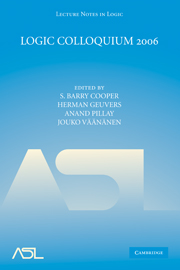Book contents
- Frontmatter
- Contents
- Introduction
- Definability and elementary equivalence in the Ershov difference hierarchy
- A unified approach to algebraic set theory
- Brief introduction to unprovability
- Higher-order abstract syntax in type theory
- An introduction to b-minimality
- The sixth lecture on algorithmic randomness
- The inevitability of logical strength: Strict reverse mathematics
- Applications of logic in algebra: Examples from clone theory
- On finite imaginaries
- Strong minimal covers and a question of Yates: The story so far
- Embeddings into the Turing degrees
- Randomness—beyond Lebesgue measure
- The derived model theorem
- Forcing axioms and cardinal arithmetic
- Hrushovski's amalgamation construction
Definability and elementary equivalence in the Ershov difference hierarchy
Published online by Cambridge University Press: 28 January 2010
- Frontmatter
- Contents
- Introduction
- Definability and elementary equivalence in the Ershov difference hierarchy
- A unified approach to algebraic set theory
- Brief introduction to unprovability
- Higher-order abstract syntax in type theory
- An introduction to b-minimality
- The sixth lecture on algorithmic randomness
- The inevitability of logical strength: Strict reverse mathematics
- Applications of logic in algebra: Examples from clone theory
- On finite imaginaries
- Strong minimal covers and a question of Yates: The story so far
- Embeddings into the Turing degrees
- Randomness—beyond Lebesgue measure
- The derived model theorem
- Forcing axioms and cardinal arithmetic
- Hrushovski's amalgamation construction
Summary
Abstract. In this paper we investigate questions of definability and elementary equivalence in the Ershov difference hierarchy. We give a survey of recent results in this area and discuss a number of related open questions. Finally, properties of reducibilities which are intermediate between Turing and truth table reducibilities and which are connected with infinite levels of the Ershov hierarchy are studied.
Introduction. In this paper we consider the current status of a number of open questions concerning the structural organization of classes of Turing degrees below 0′, the degree of the Halting Problem. We denote the set of all such degrees by D(≤0_).
The Ershov hierarchy arranges these degrees into different levels which are determined by a quantitative characteristic of the complexity of algorithmic recognition of the sets composing these degrees.
The finite level n, n ≥ 1, of the Ershov hierarchy constitutes n-c.e. sets which can be presented in a canonical form as
A (Turing) degree a is called an n-c.e. degree if it contains an n- c.e. set, and it is called a properly n-c.e. degree if it contains an n-c.e. set but no (n – 1)-c.e. sets. We denote by Dn the set of all n- c.e. degrees. R denotes the set of c.e. degrees.
Degrees containing sets from different levels of the Ershov hierarchy, in particular the c.e. degrees, are the most important representatives of D(≤ 0′). Investigations of these degree structures pursued in last two-three decades show that the c.e. degrees and the degrees from finite levels of the Ershov hierarchy have similar properties in many respects.
- Type
- Chapter
- Information
- Logic Colloquium 2006 , pp. 1 - 17Publisher: Cambridge University PressPrint publication year: 2009
- 2
- Cited by

